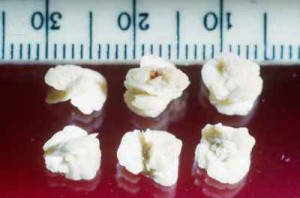Hello, my name is Elizabeth and my mother suffers from chronic kidney stones. The first time she found out that she had them was when she was pregnant with my sister who is now 18. My mother, Kim, is somewhat of a medical miracle. She has had approximately nine surgeries since she first was diagnosed with kidney stones. She has seen many doctors over the years and none of them seem to be able to find out what is the cause of her stones. At first they thought it was due to the amount of dark pop she drank so they cut that out of her diet. But that didn’t seem to help. They also tried having her drink more water to help flush out her kidneys so nothing could build up to form more stones.
 A kidney stone is formed because of abnormal levels of calcium, water, and other minerals. There are different types of stones depending on the calcium levels in your urine. Kidney stones, when big enough, can block the urine flow or get lodged in the sides of the bladder or the ureter. They are very painful, especially when you are trying to pass them.
A kidney stone is formed because of abnormal levels of calcium, water, and other minerals. There are different types of stones depending on the calcium levels in your urine. Kidney stones, when big enough, can block the urine flow or get lodged in the sides of the bladder or the ureter. They are very painful, especially when you are trying to pass them.
There are many different procedures used to get rid of kidney stones. The main ones are extracorporeal shock wave lithotripsy, ureteroscopy with laser fragmentation, or percutaneous nephrolithotmy. But what happens when a single procedure won’t help the problem? That is what nephrologists at the Mayo Clinic are studying to find out. They can predict the best type of procedure a person should have using radiographic appearance. This way they can be more accurate with the removal of stones so they can be sure to remove as many as possible.
Many new tools have been created to remove large stones from kidneys and ureters. The researchers from mayo clinic have been leading the way in these studies. One of these new studies has led to computerized tomography images of the bases of the functions. The results of these images provided the volume of the stones. The accuracy level improved by roughly 20% because of this method.
Kidney stones are a hereditary disease, but it can be prevented and cured. Many scientists have paved the way for this research, but the study is far from over. If more people were aware of the problem of kidney stones then we more studies would be available.
1. Do you know anyone with kidney stones? What treatment did they use?
2. What is one way to remove a large kidney stone from your body?
3. How does computer tomography affect what we know about stones?
1.
Computed tomography is a imaging procedure that uses X-rays and computer technology to produce images of the body. A CT scan shows detailed images of any part of the body. CT scans provide more detailed information about the kidneys than standard X-rays. Some other procedures that could be used to help diagnose kidney problems are KUB X-rays, kidney biopsy, kidney scan, kidney ultrasound, renal angiogram, and renal venogram. In an X-ray, a beam of energy is aimed at the body part being studied but in a computed tomography, the X-ray beam moves in a circle around the body. A computed tomography gets a better picture and also has more angles to the problem spot so it is used more often.
http://www.hopkinsmedicine.org/healthlibrary/test_procedures/urology/computed_tomography_ct_or_cat_scan_of_the_kidney_92,P07703/